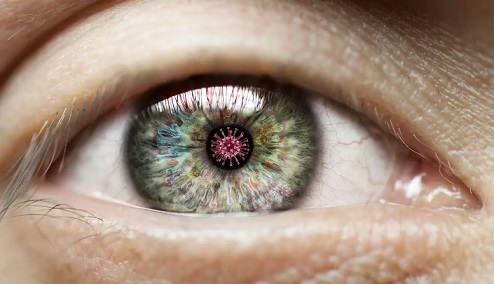Nikhil Prasad Fact checked by:Thailand Medical News Team Jun 24, 2024 9 months, 2 weeks, 5 days, 11 hours, 25 minutes ago
COVID-19 News: Understanding the Connection Between COVID-19 and Eye Problems. COVID-19, primarily known for its severe respiratory effects, has been found to impact various organs, including the eyes. Recent studies that is covered in this
COVID-19 News report have revealed rare retinal conditions in patients post-COVID-19 infection, showcasing a significant but lesser-known aspect of the virus's impact.
 COVID-19's Hidden Impact on Eyes: Unveiling Rare Retinal Conditions
The Study: A Closer Look at the Eyes Post-COVID
COVID-19's Hidden Impact on Eyes: Unveiling Rare Retinal Conditions
The Study: A Closer Look at the Eyes Post-COVID
A comprehensive study led by a group of researchers from Zhengzhou University, Henan-China and the Henan Eye Hospital at the Henan Provincial People’s Hospital, People’s Hospital of Zhengzhou University-China aimed to explore the retinal manifestations in patients who had recovered from COVID-19. This study involved 90 patients from six different hospitals who experienced visual problems immediately after recovering from COVID-19. These patients were studied between December 2022 and February 2023, and their eye conditions were evaluated using advanced imaging techniques.
Acute Macular Neuroretinopathy: A Common Finding
One of the major findings of this study was the prevalence of Acute Macular Neuroretinopathy (AMN) among the patients. AMN is a rare eye condition that affects the macula, the central part of the retina responsible for detailed vision. Out of the 90 patients, 78 were diagnosed with AMN. Interestingly, most of these patients were young women, highlighting a possible demographic trend.
Other Retinal Conditions Identified
Apart from AMN, the study also identified several other retinal conditions. These included:
-Purtscher or Purtscher-like Retinopathy: Found in 11 patients, this condition is characterized by sudden vision loss due to retinal damage.
-Vogt-Koyanagi-Harada (VKH) Syndrome: Three patients were diagnosed with VKH-like uveitis, an inflammatory condition affecting the eyes, skin, and nervous system.
-Multiple Evanescent White-Dot Syndrome (MEWDS): This rare eye condition was observed in two patients.
-Rhino-Orbital-Cerebral Mucormycosis (ROCM): Five patients suffered from this severe fungal infection, often linked to COVID-19.
Diagnostic Methods and Observations
The researchers utilized various imaging techniques to diagnose these conditions. These included:
-Optical Coherence Tomography (OCT): This technique was instrumental in detecting AMN lesions.
-Infrared Retinal Photography: Used to identify Purtscher or Purtscher-like lesions.
-Fundus Photography: Provided detailed
images of the retina, revealing different types of lesions.
Patient Demographics and Symptoms
The study participants ranged in age from 10 to 85 years, with a median age of 31 years. The majority of them experienced visual symptoms within a month of recovering from COVID-19, with a median onset of symptoms just two days post-recovery. Common symptoms reported included blurred vision and dark spots in the visual field.
Impact of COVID-19 on the Retina
The findings of this study highlight a crucial aspect of COVID-19's impact on health. The virus, by targeting the ACE2 receptors in various organs, can lead to significant retinal damage. These receptors, found in the endothelial cells of the retina, become vulnerable during a COVID-19 infection, leading to conditions like AMN and other retinal diseases.
Why This Matters
Understanding these conditions is vital for several reasons:
-Early Detection and Treatment: Recognizing these retinal conditions early can lead to timely treatment, potentially saving patients from severe vision loss.
-Awareness: Increased awareness among healthcare providers and patients can lead to better diagnosis and management of these conditions.
-Research and Development: Further research can help develop targeted treatments for these retinal conditions.
Moving Forward
The study underscores the need for comprehensive eye examinations for patients recovering from COVID-19, especially those reporting visual symptoms. With advanced imaging techniques, healthcare providers can better diagnose and manage these conditions, improving patient outcomes.
Conclusion
COVID-19's impact extends beyond the lungs, affecting various organs, including the eyes. The discovery of rare retinal conditions post-COVID-19 infection emphasizes the importance of a multidisciplinary approach to patient care. As we continue to learn about the virus's far-reaching effects, these findings pave the way for better healthcare strategies and improved patient awareness.
By staying informed and vigilant, we can better manage the long-term impacts of COVID-19 on health, ensuring comprehensive care for all affected individuals.
The study findings were published in the peer reviewed journal: Scientific Reports.
https://link.springer.com/article/10.1038/s41598-024-65216-9
For the latest
COVID-19 News, keep on logging to Thailand Medical News.
Read Also:
https://www.thailandmedical.news/news/rising-incidences-of-mewds-amid-covid-19-infections-and-vaccinations
https://www.thailandmedical.news/news/researchers-warn-that-even-mild-covid-19-can-cause-retinal-microvascular-changes-of-the-eyes
https://www.thailandmedical.news/news/sars-cov-2-is-able-to-cross-the-blood-retinal-barrier-and-cause-damage-to-the-eyes
